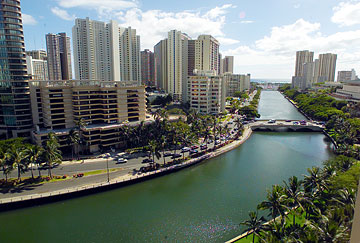Flushing could de-pollute, keep Ala Wai Canal clean
HERE'S how to solve the Ala Wai Canal pollution problem with relatively little expense, turning it into a clean-flowing waterway, ending the need for dredging and ending the nagging flotsam problem in the Ala Wai harbor:
Install down the middle of the 1.5-mile canal a concrete wall, elevated to a foot above the water surface at high tide, running from the Ala Moana Boulevard bridge to about 100 yards short of the Kapahulu end.
At or near the Ala Moana bridge, build two big counterbalanced water gates, one on each side of the medial wall and extending to the shorelines, automated to alternatively open and close on each turn of the tide. As the tide rises, one gate is open and the other closed. When the tide recedes, the first gate is closed and the second gate is opened.
Based on a 1-foot tide (actually it ranges from 1 to 1 1/2 feet), it would move about 19 million gallons of fresh sea water, flowing up one side of the canal on the rising tide, then flush 19 million gallons of canal water around the Kapahulu end and down the other side on the receding tide as the gate positions are switched.
Based on rough calculations, that is about one-eighth of the entire volume of canal water moving twice a day, meaning the canal's entire water column would be refreshed with sea water every four days, no doubt creating a good fish and marine live habitat.
 STAR-BULLETIN / 2004 From up in the Ala Wai Manor condominium, the Ala Wai Canal looks fairly clean, but looks can be deceiving. CLICK FOR LARGE |
|
IT WOULD end the current back-and-forth movement of the same stagnant and frequently polluted water on each turn of the tide. A bypassing current at the mouth of the canal likely would draw out to sea a lot of the floating junk that now builds up in the Ala Wai harbor.
The water gates would have to be built with a default wide-open configuration in the event of a dreaded 100-year flood that the Army Corps of Engineers currently is fretting.
I'm sure the lengths of concrete wall and the gates could be prefabricated elsewhere and dropped into place, minimizing on-site construction activity that always seems to bug Waikiki residents.
This might cost a couple of million bucks, or maybe even a couple more, but creating a gently moving river of clean water instead of a stagnant drainage ditch that only the tilapia love would be worth the investment.
The Army Corps of Engineers might even be able to snag some federal money for such a project, and the Waikiki Improvement Association might get the industry to kick in a few bucks.
Bruce Dunford, a former Associated Press reporter, lives in Ewa Beach.

